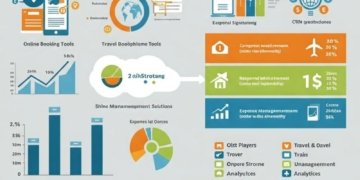The In-Flight Wi-Fi Services Market is projected to grow from US$ 8,769.0 million in 2023 to US$ 32,751.6 million by 2033, reflecting a CAGR of 14.1% from 2023 to 2033. These services enable passengers to access Wi-Fi mid-flight using air-to-ground or satellite networks, catering to the increasing demand for internet connectivity during air travel.
The demand is largely driven by passengers’ need for entertainment or work during flights, along with the widespread use of internet-enabled devices. North America held the largest market share in 2022, followed by Europe. The post-COVID-19 recovery, characterized by a rebound in air traffic and passenger numbers, has been a significant growth driver. Partnerships such as AirAsia India’s collaboration with Sugarbox and Intelsat’s deal with Tata’s Nelco to provide Wi-Fi in Indian airspace reflect the growing adoption of these services.
𝐑𝐞𝐪𝐮𝐞𝐬𝐭 𝐟𝐨𝐫 𝐒𝐚𝐦𝐩𝐥𝐞: https://www.persistencemarketresearch.com/samples/4696
𝐆𝐫𝐨𝐰𝐢𝐧𝐠 𝐃𝐞𝐦𝐚𝐧𝐝 𝐟𝐨𝐫 𝐒𝐞𝐚𝐦𝐥𝐞𝐬𝐬 𝐂𝐨𝐧𝐧𝐞𝐜𝐭𝐢𝐯𝐢𝐭𝐲
The demand for in-flight Wi-Fi has surged in recent years, as passengers increasingly expect reliable and fast internet access while traveling. North American travelers, in particular, have led the charge in this trend, with frequent flyers and business travelers relying on in-flight Wi-Fi for work, entertainment, and staying connected with loved ones. Airlines in the region are under pressure to provide high-quality internet services that can meet the needs of diverse passengers.
A major driver behind the growing demand is the increasing reliance on smartphones, tablets, and laptops during flights. Passengers expect the same level of connectivity in the air as they experience on the ground. Whether it’s streaming movies, checking emails, or browsing social media, the in-flight Wi-Fi market has become essential for modern aviation experiences.
𝐓𝐞𝐜𝐡𝐧𝐨𝐥𝐨𝐠𝐢𝐜𝐚𝐥 𝐀𝐝𝐯𝐚𝐧𝐜𝐞𝐦𝐞𝐧𝐭𝐬 𝐁𝐨𝐨𝐬𝐭𝐢𝐧𝐠 𝐌𝐚𝐫𝐤𝐞𝐭 𝐆𝐫𝐨𝐰𝐭𝐡
One of the primary factors fueling the expansion of in-flight Wi-Fi services in North America is technological innovation. In recent years, satellite connectivity has made significant strides, allowing for more reliable and faster internet connections even at high altitudes. The introduction of low-Earth orbit (LEO) satellite constellations, such as SpaceX’s Starlink, promises to further enhance the speed and reliability of in-flight Wi-Fi services.
Moreover, advancements in air-to-ground connectivity have also contributed to the market’s growth. These technologies leverage existing terrestrial networks, allowing for improved data transmission while in-flight. As these technologies continue to evolve, passengers can expect an even more seamless internet experience.
𝐌𝐚𝐣𝐨𝐫 𝐀𝐢𝐫𝐥𝐢𝐧𝐞𝐬 𝐢𝐧 𝐍𝐨𝐫𝐭𝐡 𝐀𝐦𝐞𝐫𝐢𝐜𝐚 𝐋𝐞𝐚𝐝𝐢𝐧𝐠 𝐭𝐡𝐞 𝐂𝐡𝐚𝐫𝐠𝐞
North American airlines have been at the forefront of the in-flight Wi-Fi revolution. Carriers such as American Airlines, Delta Air Lines, and United Airlines have invested heavily in enhancing their in-flight connectivity offerings, catering to the growing needs of passengers.
American Airlines, for instance, has committed to installing high-speed internet on its entire fleet, ensuring that passengers can access the web during domestic and international flights. Similarly, Delta Air Lines has partnered with satellite companies to upgrade its Wi-Fi infrastructure, offering free Wi-Fi on certain flights and providing improved speed and reliability.
These airlines’ commitment to in-flight connectivity has set a high standard for the global aviation industry. With competition heating up, other airlines are also following suit to ensure they do not fall behind in the race to offer superior in-flight experiences.
𝐁𝐮𝐬𝐢𝐧𝐞𝐬𝐬 𝐓𝐫𝐚𝐯𝐞𝐥 𝐃𝐫𝐢𝐯𝐞𝐬 𝐈𝐧-𝐅𝐥𝐢𝐠𝐡𝐭 𝐖𝐢-𝐅𝐢 𝐀𝐝𝐨𝐩𝐭𝐢𝐨𝐧
Business travelers, a key segment of the in-flight Wi-Fi market, are driving demand for reliable and fast internet during flights. The need for constant connectivity while on the go has become a necessity for many professionals who require access to emails, video conferencing, and cloud-based applications.
In North America, business travel remains strong, and with it, the demand for in-flight Wi-Fi continues to rise. Airlines have responded by offering services tailored to the business traveler, including premium Wi-Fi packages, faster internet speeds, and more extensive in-flight entertainment options. This focus on the business segment is further contributing to the growth of the in-flight Wi-Fi market.
𝐓𝐡𝐞 𝐑𝐨𝐥𝐞 𝐨𝐟 𝐋𝐨𝐰-𝐂𝐨𝐬𝐭 𝐂𝐚𝐫𝐫𝐢𝐞𝐫𝐬 𝐢𝐧 𝐄𝐱𝐩𝐚𝐧𝐝𝐢𝐧𝐠 𝐌𝐚𝐫𝐤𝐞𝐭 𝐑𝐞𝐚𝐜𝐡
Low-cost carriers (LCCs) have also played a significant role in driving the growth of in-flight Wi-Fi in North America. Traditionally, LCCs have been slow to adopt high-tech services like in-flight Wi-Fi due to the cost associated with implementing such technologies. However, the rise in passenger expectations and the need to remain competitive have pushed many budget airlines to offer Wi-Fi services.
Southwest Airlines, one of the largest low-cost carriers in the U.S., offers free in-flight Wi-Fi to its passengers. This move has put pressure on other budget airlines to follow suit, increasing the overall availability of in-flight connectivity.
As more LCCs introduce or upgrade their Wi-Fi offerings, the market share of in-flight Wi-Fi services in North America will continue to grow, further reinforcing the region’s dominant position in the global market.
𝐂𝐡𝐚𝐥𝐥𝐞𝐧𝐠𝐞𝐬 𝐅𝐚𝐜𝐢𝐧𝐠 𝐭𝐡𝐞 𝐍𝐨𝐫𝐭𝐡 𝐀𝐦𝐞𝐫𝐢𝐜𝐚𝐧 𝐈𝐧-𝐅𝐥𝐢𝐠𝐡𝐭 𝐖𝐢-𝐅𝐢 𝐌𝐚𝐫𝐤𝐞𝐭
Despite the rapid growth, the in-flight Wi-Fi market in North America faces several challenges. One of the main hurdles is the high cost of installing and maintaining in-flight Wi-Fi systems. For airlines, these investments are substantial, especially when upgrading fleets with the latest connectivity technology.
Furthermore, providing high-speed, reliable internet in-flight presents technical difficulties. The aviation industry must address the limitations of satellite and air-to-ground connectivity systems, including issues related to bandwidth, signal interference, and latency. These challenges are particularly significant for long-haul flights, where the need for seamless internet connectivity is most critical.
𝐎𝐩𝐩𝐨𝐫𝐭𝐮𝐧𝐢𝐭𝐢𝐞𝐬 𝐟𝐨𝐫 𝐆𝐫𝐨𝐰𝐭𝐡 𝐚𝐧𝐝 𝐄𝐱𝐩𝐚𝐧𝐬𝐢𝐨𝐧
The North American in-flight Wi-Fi market is brimming with opportunities for growth. As airlines continue to innovate and enhance their services, the market is expected to expand further, with new technologies offering better, faster, and more reliable internet access during flights.
One of the most promising areas of growth is the increasing adoption of 5G technology in aviation. Once 5G infrastructure is fully integrated into airline fleets, passengers can expect lightning-fast internet speeds and significantly improved connectivity. This breakthrough will revolutionize the in-flight experience and further drive demand for Wi-Fi services.
Moreover, as the aviation industry recovers from the impact of the COVID-19 pandemic, the demand for air travel is expected to increase, driving the need for better in-flight Wi-Fi. Airlines will need to adapt to the growing expectations of passengers who demand a seamless and connected travel experience.
𝐂𝐨𝐧𝐜𝐥𝐮𝐬𝐢𝐨𝐧: 𝐍𝐨𝐫𝐭𝐡 𝐀𝐦𝐞𝐫𝐢𝐜𝐚 𝐋𝐞𝐚𝐝𝐬 𝐭𝐡𝐞 𝐖𝐚𝐲
North America’s commanding 28.5% share of the global in-flight Wi-Fi market reflects the region’s significant role in shaping the future of in-flight connectivity. With a combination of rising passenger expectations, technological advancements, and strategic investments by major airlines, North America remains at the forefront of this rapidly growing sector. As airlines continue to embrace innovation, the in-flight Wi-Fi market is poised for further expansion, benefiting travelers and airlines alike in the years to come.
𝐂𝐨𝐧𝐭𝐚𝐜𝐭 𝐔𝐬:
Persistence Market Research
G04 Golden Mile House, Clayponds Lane
Brentford, London, TW8 0GU UK
USA Phone: +1 646-878-6329
UK Phone: +44 203-837-5656
Email: sales@persistencemarketresearch.com
Web: https://www.persistencemarketresearch.com
𝐀𝐛𝐨𝐮𝐭 𝐏𝐞𝐫𝐬𝐢𝐬𝐭𝐞𝐧𝐜𝐞 𝐌𝐚𝐫𝐤𝐞𝐭 𝐑𝐞𝐬𝐞𝐚𝐫𝐜𝐡:
At Persistence Market Research, we specialize in creating research studies that serve as strategic tools for driving business growth. Established as a proprietary firm in 2012, we have evolved into a registered company in England and Wales in 2023 under the name Persistence Research & Consultancy Services Ltd. With a solid foundation, we have completed over 3600 custom and syndicate market research projects, and delivered more than 2700 projects for other leading market research companies’ clients.
Our approach combines traditional market research methods with modern tools to offer comprehensive research solutions. With a decade of experience, we pride ourselves on deriving actionable insights from data to help businesses stay ahead of the competition. Our client base spans multinational corporations, leading consulting firms, investment funds, and government departments. A significant portion of our sales comes from repeat clients, a testament to the value and trust we’ve built over the years.
This release was published on openPR.


















